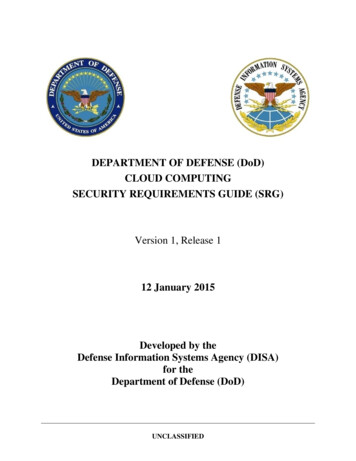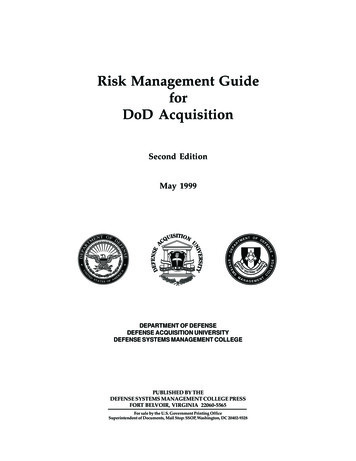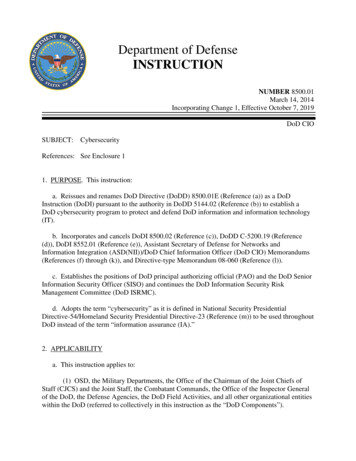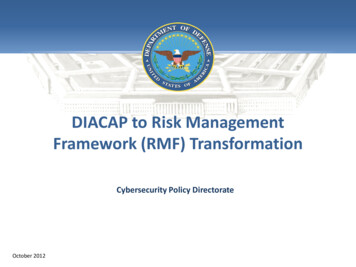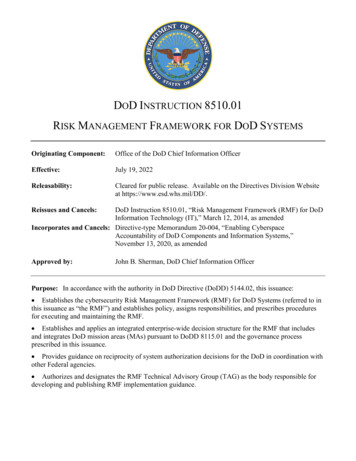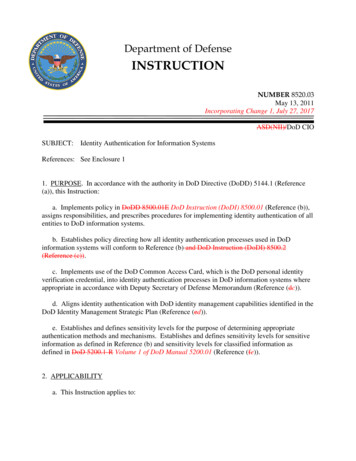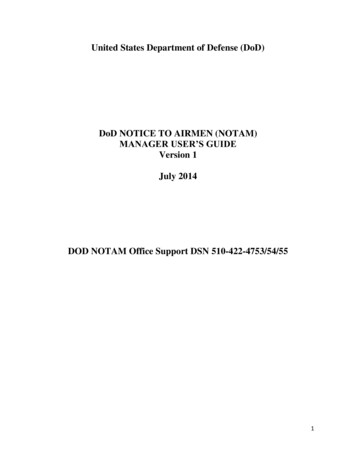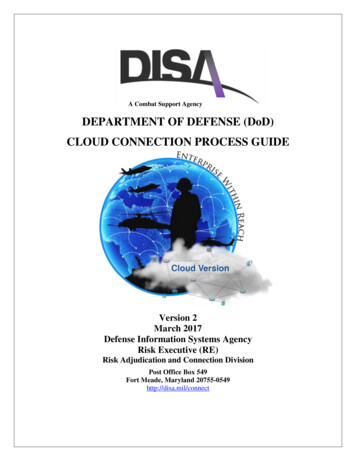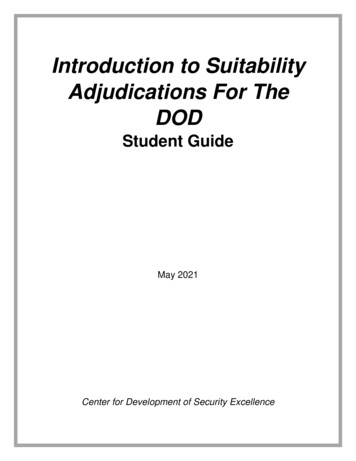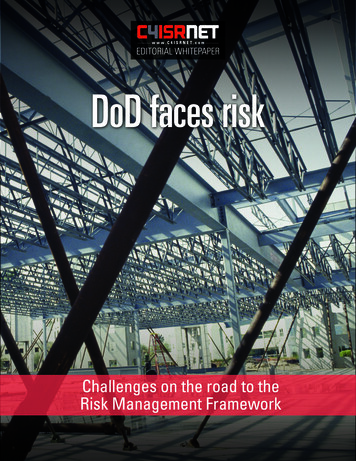
Transcription
EDITORIAL WHITEPAPERDoD faces riskChallenges on the road to theRisk Management Framework
DOD FACES RISKChallenges on the road to theRisk Management FrameworkBY ADAM STONEThe paper, while aimed at Air Force systems, could apply equallyacross all DoD components. “The stakeholders for cybersecurityin the Air Force are confronted with a welter of laws and policiesthat are voluminous, complicated, and changing faster than the lifecycle of a military system,” the authors write. That rapid pace ofchange certainly impacts RMF adoption, but it’s not the only causefor delays.Drawing from the Splunk findings, this paper will explore themost common hurdles encountered by military IT professionalsas they strive to align their systems with the RMF security vision.We’ll look at the likely sticking points, explore best practices andfinally lay out a vision for what steps IT can take to accelerate themove toward an RMF environment.In March 2014 the Defense Department’s then-CIO Teri Takaichanged the face of IT security across the military when shecalled for the transition from the DoD Information AssuranceCertification and Accreditation Process, or DIACAP, to the National Institute of Standards and Technology (NIST) Risk ManagementFramework, or RMF.The transition to RMF, now underway and slated for completion by mid-2018, marks a sweeping cultural shift in the department’s approach to IT security. DIACAP established a standardset of activities to certify and accredit DoD information systems, and looked to refresh every three years. RMF, on the otherhand, takes a dynamic approach, focusing on risk managementas its primary approach and emphasizing a need for ongoingcontinuous monitoring.Some in defense are rising to the challenge. The Army’s MedicalCommunications for Combat Casualty Care (MC4) organization,for example, declared it had reached full implementation of RMFin 2015. Others have been slower to adopt the new standards, according to a recent survey by Splunk, a provider of a data-analyticsplatform for security and other IT-driven business needs.Splunk found that among defense IT leaders SIX STEPS TO RMF IMPLEMENTATIONIn order to explore the challenges impeding RMF adoption, it’shelpful to first take a high-level view of the actual requirement. TheRMF asks IT planners to consider security as a function of risk:How likely a negative event is to happen; how severe might theconsequences be if it did. With this in mind, the RMF then directs asix-step approach to mitigating risk. One-third report that less than half of their informationsystems have baseline security controls, based on thesecurity categorization.Nearly half say that less than 50 percent of their securitycontrols have been implemented with the deploymentapproach documented.Almost 40 percent say they fall well short of the RMF’sprescription for frequent and ongoing reviews. It is perhaps not surprising that so many defense and intelligencecommunity technology leaders find themselves struggling to adoptthe RMF. The Rand Corporation sums up the situation in a research paper titled Improving the Cybersecurity of U.S. Air ForceMilitary Systems Throughout Their Life Cycles.Categorize the information that is processed, storedand transmitted on the system.Select an initial set of controls for the information system,culled from a NIST menu of over 360 possible controls.Implement the controls, documenting what actions youare taking and why they make sense.Assess the controls. Review the implementation toensure it is meeting the mission.Authorize the IT operation, now secure.Monitor the performance of the security controlscontinuously.The RMF does not specify the mechanics of security fordefense or intelligence community systems. NIST offers ahundreds-long menu of possible controls, but it is up to theC4ISRNET.com/wp/dodfacesrisk2
DOD FACES RISKsystem owner to determine what will best meet the need.Rather than give a prescription for security, “RMF is meant togive people hope, and a process to rally around,” said NISTFellow Ron Ross.That process hasn’t always been easy to implement. Consider thefollowing challenges.age of security controls have been implemented with deploymentapproach documented? Forty-six percent admitted than less thanhalf their security control implementations have been properlydocumented.It’s true that the RMF does ask IT leaders to document their security choices, but while some may find this onerous, NIST’s Rosssays the requirement is not nearly so heavy-handed as some mightthink. “This is something that is constantly raised as a negative aspect of the RMF, but there is nothing in the process that demandsan excessive degree of documentation,”he said.In fact, documentation serves a vitalrole in IT security, especially in an organization like the DoD, where turnovermay run high as civilians swap out to theprivate sector and uniformed staff movethrough their rotations. “You have a constant churn of personnel and if things arenot well documented someone is goingto spend a lot of time trying to figure outwhat the last guy did, and so operationaleffectiveness suffers,” Stoner said.The key to success here is to systematize. “You need to make it part ofoperations,” said Matt Coose, CEO and founder of cybersecurityconsultancy Qmulos. “For example, you get new user accountrequests all the time. As part of that process the group canautomatically review all users and see if there is anyone whoneeds to be taken out. Then it is not a separate exercise. The[creation] of that documentation is just a byproduct of doingyour normal operations.”DODGING RISKSplunk asked IT leaders: Within your office or agency, what percentage of information systems have setbaseline security controls based on thesecurity categorization? Nearly a third ofrespondents said than less than half oftheir systems met this mark. Yet categorizing risk is a crucial first step in RMFcompliance.“Before you can set controls, youhave to categorize systems,” saidSplunk Security Strategist John Stoner.“There are ways to talk about the criticality of a system, ways to talk aboutNIST Fellow Ron Rossthe confidentiality of the data, to talkabout system availability and the integrity of the data. These are basic initialcategorizations that you need in order to select controls.”Sometimes people may be reluctant to set even the most elementallevels of risk categorization: High, medium and low. Technology managers in DoD and the IC may shy away from taking this step becauseit is a de facto admission that risk exists. There is “an unwillingnessto articulate in writing their risk tolerance,” according to MITRE, inthe RMF research report Beyond Compliance. In the report, MITREauthors note that such an approach is counterproductive “due to continually evolving adversary capabilities and intentions. Some riskswill always materialize, and they need to be managed.”Security experts shy away from such an admission, but the failure to admit risk is generally an unrealistic stance.“This is a world where you have threats and bad actors, andwhere you have systems with inherent vulnerability,” Ross said.“You can wish you didn’t live in a risk-based world but anyonewho’s driven on the highway or ridden on an airplane understandsthat there is risk in everything we do. You can’t ignore that andhope it will go away. There will always be vulnerabilities.”“You can wish you didn’tlive in a risk-based world,but anybody who’s drivenon a highway understandsthere is risk in everything we do.”COMPLIANCE MENTALITYClose observers of the military IT environment say the effort tocomply with the RMF may, in itself, be a hurdle to compliance.Why? Because for many, “compliance” exists as the end goal. Theyevaluate and remediate simply in order to check the box labeled“RMF compliant.” But that approach can be counterproductive.Take the fundamental activities of account management as anexample. IT needs to know who logs in and out, where they go in thesystem and what they do there. “People will collect that and showthat as part of the compliance requirement. They will buy tons ofsoftware to parse that data into a specific relational database just forthe sake of showing and proving compliance. Then they will build acompletely separate system for security [operations], where you cansee that data in real time, where the data is dynamic,” Coose said.DEARTH OF DOCUMENTSPaperwork is another common stumbling block in adopting theRMF. The survey asked: Within your office or agency, what percent-C4ISRNET.com/wp/dodfacesrisk3
DOD FACES RISKTHE BIG PICTUREThis compliance-centric approach is a common pitfall in a regulated IT environment. “This is not just a DoD thing,” Ross said.“If you look at the power plants for instance, or look at HIPAA,people are trying to follow the law and they are working in acompliance mentality.” By thinking only in terms of compliance,people fail to leverage the full potential of the RMF and ultimately fall short of its actual aim, which is to create safer systems.In its RMF guiding document, the DoD Defense Security Service(DSS) spells out this need to look beyond the mere letter of theRMF instruction. “More than simply achieving compliance, implementing RMF will assure leadership that security personnel haveused critical thinking to ascertain the threat picture, assess risks,and have instituted sufficient security controls to protect assetsfrom theft and organization information systems from intrusion,”according to DSS.Where is the Risk Management Framework taking militaryIT? The National Institute of Standards and Technology(NIST) offers these as the essential characteristics of RMF: FIX-AND-FORGETOne of the main tenets of the RMF is the call for ongoing reviewand revision. It’s a place where many fall short, the Splunk studyfound. Asked how often security controls are assessed to determine status of implementation, functionality and effectiveness, 37percent said they do it annually, biannually or never. Asked whatpercentage of authorized information systems are assessed andmonitored on an ongoing basis, 39 percent say less than half.Yet ongoing review is a basic principle of the RMF, and withgood reason. As RAND researchers note, cyber risk to the military“changes over time as systems are upgraded or new attacks areenabled by newly discovered vulnerabilities; therefore risk assessments need to be conducted with sufficient regularity to keep upwith the pace of change.”When this doesn’t happen, the fault is usually cultural. “In thepast, folks have said: ‘I will certify the system and until somethingsubstantial changes, I am good.’ Now under the RMF process, thatis changing,” Stoner said. “The expectation now is that you willbe constantly monitoring, that your security controls will changeas your system changes. The mission may evolve, the softwaremay change, and you will be pulling out security controls, updating them, getting rid of those that are no longer necessary. RMFintends for that to be a constant loop.” Promotes the concept of near real-time risk management and ongoing information system authorizationthrough the implementation of robust continuousmonitoring processesEncourages the use of automation to provide seniorleaders the necessary information to make costeffective, risk-based decisionsIntegrates information security into the enterprisearchitecture and system development life cycleProvides emphasis on the selection, implementation,assessment, and monitoring of security controls, andthe authorization of information systemsLinks risk management processes at the informationsystem level and organization levelEstablishes responsibility and accountability forsecurity controlsGiven these myriad challenges, many will find that a technological implementation rooted in big data can help to ensure a smoothRMF implementation. Along these lines, automation holds particular promise, said one DoD official.“It takes a lot of time and effort for someone to do all these scansand analyze them and publish those results,” said Kevin Dulany,chief of the Risk Management Framework Division in the Officeof the Secretary of Defense. “If we leverage automation, I can geta more complete risk picture and I can do it more often. I can getmore of an up-to-date picture and I can be more efficient in findingmy major problems and allocating my resources.”The number of possible controls and their relative merits “is toomuch for any human being” to manage, MITRE reports. In suchcircumstance, automated tools “are necessary to aid security practitioners in making informed decisions regarding the effectiveness,cost and relevance of the various controls in different environments and different threat settings.”IT in general has been slow to adopt the tools of automation. In asurvey of IT security professionals, the Ponemon Institute found thatwhen it comes to keeping up with security changes, only 15 percentare using automated risk impact assessments and just 13 percent saythey are using continuous compliance monitoring. Yet there is muchTHE AUTOMATION FIXClearly IT planners face a number of potential pitfalls on the roadto RMF compliance. They may be reluctant to categorize risk. Theymay resist the call to document their actions, they may think toonarrowly in terms of compliance or they may fail to implement thecritical process of ongoing review.C4ISRNET.com/wp/dodfacesrisk4
DOD FACES RISKcontinuous security and compliance monitoring, rapid detectionand fast incident response capabilities it needs.There is much that automation can help to achieve when itcomes to RMF implementation, creating a valuable context forsecurity data and thus enabling deeper insights. At the sametime, technology alone won’t take IT planners across the finishline. At the end of the day RMF represents a fundamental cultural shift, a very different way of understanding and approachingIT security.It’s no longer sufficient to check the box: There’s no one rightway to implement security in the RMF world. Rather, compliancecomes through ongoing engagement and a persistent, thoughtfulexploration of both external threats and internal vulnerabilities.Understanding and embracing the notion of risk thus becomes thecritical first step on the road to RMF implementation. nto be gained from an automated approach.Take, for example, security information and event management,or SIEM, the real-time analysis of security alerts generated by network hardware and applications. Analytic-driven security solutionscan leverage network and application security logs to correlateand detect threats on risky behavior, tracking not just where a usergoes inside the system but what files and processes they might tapinto, what documents they may download or what materials theymay try to exfiltrate from the system.“You need to understand what your system can do and whatthe acceptable behaviors for that system look like. Then youcan put up guardrails. Then you start to get alerts when behavior seems out of step with those limits,” Stoner said. Given thecomplexity and fast-changing nature of today’s threats, defenseIT needs this kind of big-data type approach if it is to achieve theThank you to our underwriterC4ISRNET.com/wp/dodfacesrisk5
al Institute of Standards and Technology (NIST) Risk Management Framework, or RMF. The transition to RMF, now underway and slated for comple-tion by mid-2018, marks a sweeping cultural shift in the depart-ment's approach to IT security. DIACAP established a standard set of activities to certify and accredit DoD information sys-
